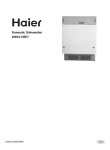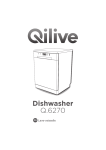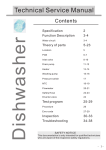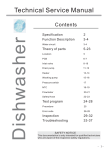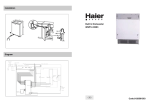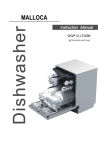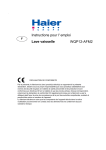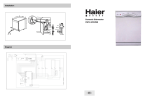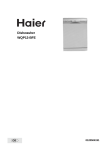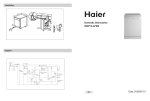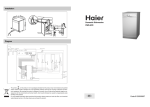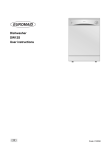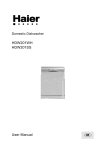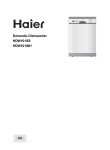Download Haier WQP12-CFESS User's Manual
Transcript
Domestic Dishwasher WQP12-CFESS Code:0120502885 Safety Is a Good Habit to Get Into Close-up View (Interior) - This appliance cannot be installed outdoors or exposed to the rain and elements. Not even if the area in which it is installed is covered by a roof. It is very dangerous. - Do not lean or sit on the door when it is open, as this could overturn the dishwasher. - If the appliance malfunctions, turn off water supply to the appliance and disconnect the plug from the wall socket. Then, refer to the "Troubleshooting section on page 8." If you cannot resolve the problem, contact an authorised service agent. - Only specialised personnel are authorised to make repairs. - Appliances which are being discarded must be made inoperable by cutting the power supply cord and removing the door lock. - The appliance must be positioned so that the plug or isolating switch is accessible. - If the supply cord is damaged, it must be replaced by the manufacturer or an authorised service agent. IMPORTANT Carefully read the instructions contained in this manual, as it provides information that is essential to safe and proper installation, use and maintenance of this appliance. This appliance complies with following EEC directives: - 73/23/EEC of 19/02/73(Low Voltage)and subsequent modifications; - 89/336/EEC of 03/05/89 (Electromagnetic Compatibility) and subsequent modifications. - Carefully dispose of the packing material. - After removing the packing, check to make sure that the appliance is not damaged. If in doubt, contact a qualified professional. - The dishwasher must only be used by adults for the washing of household dishes and cooking utensils. - Fundamental rules to follow when using the appliance: * Never touch the dishwasher with wet hands; * We discourage the use of extension cords and multiple sockets; * During installation, the power supply cord must not be excessively or dangerously bent or flattened; * If the appliance is not operating properly or, requires maintenance, disconnect the appliance from the power supply. - Keep detergents out of the reach of children. Also keep chil dren away from the dishwasher when it is open to reduce the risk of injury. L V J E F E Dishwasher Detergents can be extremely dangerous, if swallowed. Avoid contact with skin and eyes and keep children away from the dishwasher when the door is open. Check that the detergent receptable is empty after completion of the wash cycle. D J L I Warning: Close-up View (control panel) F C B A B C D K G H A Cup Rack G Washing Filter B Upper Rack H Turbo Dry-fan C Rack Height Adjustor I Detergent and Rinse Aid Dispenser D Top Spray Arm J Silverware basket E Lower Rack K Knife rack F Bottom Spray Arm L Third Sprayer A Technical characteristics R 6h 1 2 G H 4h 2h 1 0 WQP12-CFESS I J Width 60 cm Depth 60 cm Height 85 cm 12 standard place settings Capacity A ON-OFF Button F Cycle indicator light B ON-OFF Light G Cycle select button C "HALF LOAD" Button H "HALF LOAD" indicator light D Low rinse aid indicator light I Delay indicator light E Water heating indicator light J Delay select button .1. Mains water pressure 0.03-0.6MPa Power voltage 220-240V~ Total absorber power 2150W .2. Detergent and Rinse Aid Loading the Dishwasher Detergent Rinse Aid Detergent specifically intended for use with dishwashers must be used. The dispenser must be refilled before the start of each This product makes dishes sparkle and helps them to dry without spotting. The dispenser is located on the inside panel of the wash cycle following the instructions provided in the "Wash Cycle Table." The detergent dispenser is located on the inside panel of door and should be filled after approx every 80 wash cycles (or when the "low rinse aid" indicator light comes on for those mod- the door. els with this feature). Lower Rack Before placing the dishes in the dishwasher, remove larger food particles to prevent the filter from becoming clogged, which re- Upper Rack sults in reduced performance. If the pots and pans have baked-on food that is extremely hard to remove, we recommend that they are soaked before washed. This will eliminate the need for extra wash cycles. Pull out the rack to load the dishwasher. How to use the lower rack Loading the detergent To open the "A" cover on the dispenser, press the "B" button. The detergent for the wash cycle should be poured into the "C" Loading the Rinse Aid Regardless of the type of detergent dispenser installed on your We recommend that you place the most difficult to clean items on the bottom rack: pots, pans, lids, serving dishes and bowls, as compartment. After the detergent has been placed in the dispenser, close the appliance, you must proceed as indicated below when loading the rinse aid. shown in the figure to the right. It is preferable to place serving dishes and lids on the sides of the cover and press down until it clicks into place. To open the dispenser, turn the "C" cap in an anti-clockwise direction and then pour in the rinse aid, making sure not to overfill. racks in order to avoid blocking the rotation of the top spray arm. - Pots, serving bowls, etc. must always be placed face down. The amount of rinse aid used for each cycle can be regulated by turning the "F" dose adjustor, located beneath the "C" cap, with - Deep pots should be slanted to allow the water to flow out. - The lower rack features fold down tine rows (see fig.A) so that a screwdriver. There are 6 different settings; the normal dosage setting is 3. larger or more pots and pans can be loaded. - The silverware basket can be halved (see fig.B) so that only C Load for 12 Standard Settings one section may be used when the silverware load is light. This also makes space for additional pots and pans and it can also be A Important Proper dosage of the rinse aid improves drying. If drops of water remain on the dishes or spotting occurs, B the dosage adjustor should be turned to a higher setting. If the dishes have white streaks, turn the dosage adjustor to a lower setting. placed in the upper rack. - Silverware should be placed in the silverware basket with the fig.A fig.B fig.C fig.D handles at the bottom; if the rack has side baskets, the spoons should be located individually into the appropriate slots. Long utensils should be placed in a horizontal position in the upper rack. How to use the upper rack The upper rack is designed to hold more delicate and lighter dishware, such as glasses, cups and saucers, plates, small bowls and shallow pans (as long as they are not too dirty). Notice: To enable the cover to close, remove any excess detergent from the edges of the dispenser. C - Position the dishes and cookware so that they do not get moved by the spray of water. F The upper rack can be adjusted for height by using the knobs located on both sides of the rack itself (see fig.C). C Adjust the upper basket to the higher level and you have more space to accommodate those taller pans and trays in the bottom basket. Shelf Lean tall glasses and those with long stems against the shelf-not against other items to be washed. Place glasses, cups and small bowls on the additional cup rack. The additional cup rack can be swivelled in or out as required(see fig.D). Knife rack The knife rack clips onto the side of the top basket, giving you the freedom to wash your large sharp knives separately and out of fig.E harm’s way (see fig.E). .3. .4. Starting the Appliance Wash Cycle Table Starting a wash cycle At the end of the wash cycle... After having completed all of the installation steps in the preceding paragraphs, turn on the water to the unit, partially open the Six beeps will indicate that the wash cycle has finished and the cycle indicator light “F” will begin to extinguish. Open the door, door of the dishwasher, and press the ON-OFF button "A" located on the control panel. The "B" indicator light will come on. turn off the appliance using the ON/OFF switch and turn off the water supply to the unit. Wait a few minutes before removing the At this point, the appliance is on and ready to be programmed. dishes so as to avoid handling them while still hot (when they are more susceptible to breakage) and to get better drying results. Setting and Starting a wash Cycle Setting The Start Delay Time Choose the desired cycle by pressing the cycle selection button Open the door of the dishwasher partially. Press button "J" (see, Close-up View" Control Panel") to delay the starting time for a "G". Each time it is pressed, the cycle indicator lights "F" will change to indicate the cycle selected. wash cycle. .1st press, “2h” indicator comes on, the cycle will start in 2 hours. Choose the wash cycle you feel is most appropriate for the type of dishes that need washing (consult the wash cycle table contained in this manual, especially when first using the appliance). Close the door and after a few seconds, The wash cycle will begin. Read the paragraph entitled, "Cancelling or changing a cycle while underway. "The end of the cycle will be signalled by six beeps, Very dirty dishes, pots and pans. (Not to be used with deli- Heavy Duty (IEC-EN50242) Normal dirty dishes, .3rd press, “6h” light indicator comes on, the cycle will start in 6 hours. pots and pans. Standard daily cycle. Cancelling or changing a cycle while underway... .6th press, “2h” , “4h” and “6h” light indicators come on, the cycle will start in 12 hours. Premise: A cycle that is underway can only be changed if it has only been running for a short time. .last press, all light indicators will extinguish and you can reset. After selecting the delay time, the wash cycle can be set, as case, the detergent dispenser must be refilled (see the paragraph entitled, "Loading the Detergent"). Normal Wash Extended wash at 56 Rinse with hot water. Drying. Normal dirty dishes, pots and pans without dried on residue. Pre-wash with cold water. Extended wash at 56 Rinse with cold water. Rinse with hot water are sensitive to higher. Run immediately after dishes are Hot rinse. If necessary, they can be cancelled by pressing cycle selector "P" for about 5 seconds. Glassware a) During the delay period, none of the settings can be modified. start again when the power has come back on, or when the door has been closed. dirty dishes right after they are used. No dry- Rapid Wash . Rinse with warm water. Rinse Short wash at 40 water and electrical energy. It cannot be used with the heavy duty wash cycles. ing cycle. pots and pans while waiting for the load to Short cold wash to prevent be completed after the subsequent meal. the dishes The cycle of heat washing and dry tableware. Heat washing. food residue from drying on Heat wash .5. . Cold rinse. This button (see" Close-up View-Control Panel", letter "C") makes it possible to wash dishes using only the upper rack if there are not enough dishes for a full load, This will allow you to save on 15g Drying. Pre-wash of dishes, Wash Cycle Adjustment Buttons 1/2 Load Button used. Economic, fast cycle to be used to on not very b) If the power to the appliance goes off or the door is opened during the delay period, the clock will stop the countdown. It will 30g Drying. Light Wash down. During this period the delay indicator light (I) will blink. At the end of the delay time, the indicator will stop blinking and the Once the cycle has been cancelled, the dishwasher will emit a short acoustic sound and the relative indicator light will turn off. 30g Rinse with cold water. Wash at 58 NOTE: 30g . Rinse with cold water. Economic, fast cycle to be used for delicate items which cycle will start. Detergent Pre-wash with cold water. Extended wash at 56 Rinse with cold water. Rinse with hot water Drying. explained in "Starting a wash cycle..." There will be a short acoustic signal, and at this point the delay period will begin to count To change the cycle currently underway, open the door, press the "G" programming button and hold it in for about 5 seconds. To set a new wash cycle, follow the instructions contained in the paragraph entitled, "Setting and Starting a Wash Cycle." cate items) Description of Cycle Pre-wash with cold water. .5th press, “4h” and “6h” light indicators come on, the cycle will start in 10 hours. Otherwise, the detergent may have already been used, and the appliance may have already drained the wash water. If this is the Cycle Selection Information .2nd press, “4h” light indicator comes on, the cycle will start in 4 hours. .4th press, “2h” and “6h” light indicators come on, the cycle will start in 8 hours. and the indicator light "F" will extinguish. Cycle .6. 15g Rinse Aid Troubleshooting Energy Saving Tips -It is important to try and run the dishwasher when it is fully loaded in order to save on energy. In order to prevent odors -Use the right amount of detergent: if you use too much detergent, the result will not be cleaner dishes, but, rather, a greater If the dishwasher does not function or does not function properly. Before calling for assistance, check to see what can be done from forming and food from caking onto the dishes, you can run the hold cycle. negative impact on the environment. first: have you forgotten to press one of the buttons or to perform an essential operation? Error Messages The dishwasher is equipped with a safety system that is able to detect operating problems and malfunctions. These malfunctions -Choose the right wash cycle: the choice of cycle depends on are signalled by the rapid blinking of one of the "M" program LEDs. Only in the case where the indicator light for the soak cycle (see the type of dishware, cookware and utensils being washed and how dirty they are. table for cycles) blinks rapidly should you cancel the cycle as described in the section entitled, "Changing a Cycle while Under- The Dishwasher Does Not Start How to keep Your Dishwasher in Shape When You Go on Holiday After every wash, turn off the water supply to the appliance and When you go on holiday, it is recommended that you run a wash leave the door slightly ajar so that moisture and odors are not trapped inside. cycle with the dishwasher empty and then remove the plug from the socket, turn off the water supply and leave the door of the Remove the plug appliance slightly ajar. This will help the seals last longer and prevent odours from forming within the appliance. The Dishwasher Does Not Fill With Water Moving the Appliance Have you checked whether: plug from the socket. Do not run risks. If the appliance must be moved, try to keep it in a vertical position. If absolutely necessary, it can be positioned on its back. No solvents or Abrasive Cleaning Products To clean the exterior and rubber parts of the dishwasher, do not use solvents or abrasive cleaning products. Rather, use only a Seals cloth and warm soapy water. To remove spots or stains from the surface of the interior, use a One of the factors that cause odours to form in the dishwasher is food that remains trapped in the seals. Periodic cleaning with a cloth dampened with water and a little while vinegar, or cleaning product made specifically for dishwashers. damp sponge will prevent this from occurring. If, despite all these checks, the dishwasher still does not function and/or the problem persists, contact the nearest authorised service centre and provide them with the following information: - the nature of the problem; - the model number AND - the water is turned on and the hose is connected properly; - the water supply to the house is on and has sufficient pressure; serial number, which are on the plate located on the side of the inner part of the door. - the water supply hose is crimped or bent; - the filter in the water supply hose is clogged. Never call on unauthorised technicians and refuse to allow parts to be installed that are not original spare parts. The Dishes Are Not Clean Have you checked whether: - Dishwasher was loaded properly. Jets of water could not reach Filter Assembly Cleaning the Spray Arms - Items in the rack were touching each other; - Not enough detergent was added to dispenser; For best performance and results, the filter assembly must be Check the spray arms periodically and clean them when needed. - Selected wash programme was intensive enough; - Rotation of spray arm was obstructed by dish, etc; - Nozzles in spray arm are blocked by remnants of food; - Coarse or fine filter or microfiller is blocked; allowing it to be recirculated during the cycle. For this reason, it is a good idea to remove the larger food particles trapped in the filter after each wash cycle by rinsing the "A" semi-circular filter and cup under running water. To remove the filter assembly, pull A on the cup handle in an upward direction. The entire filter assembly (made up of the "A" semicircular filter and the "B" fine filter) - Filters have been incorrectly fitted; - Drain pump is jammed; B The Dishwasher Does Not Drain should be cleaned at least once a week. To clean the filter and the fine filter, use a cleaning brush. Then, reassemble the filter parts as shown in the figures below and reinsert the entire assembly in the dishwasher, positioning in its Cleaning the Water Inlet Filter seat and pressing downward. The dishwasher must never be outlet of the water supply tap. After turning off the water tap, unscrew the end of the water sup- used without the filters. Improper replacement of the filters may re- ply hose, remove the filter and clean it carefully under running water. Then, return the filter to its place and tighten the water duce the performance level of the appliance and damage dishes and supply hose back into position. utensils. the appliance and call for technical assistance, advising which lights were flashing. - the ON-OFF switch is on "ON"; - the water supply is turned on. all parts of the dishes, etc; - Too many items in the rack; Cleaning and Special Maintenance cleaned frequently. The filter efficiently removes food residue from the wash water, technical assistance, indicating which light was flashing. If any of the other indicator lights begin to blink rapidly, turn off - the power is on in the house; - the door is closed properly; After Every Wash Before cleaning or performing maintenance, always remove the way." Then check to make sure that there is water in the mains and that the tap is turned on. If the problem continues, call for Have you checked whether: - the plug is pushed into the socket correctly; Have you checked whether: - the drain hose is crimped or bent. Periodically clean the water inlet filter (see figure) located on the .7. Lime Deposits or a White Film Form on the Dishes Have you checked whether: - the rinse aid dosage is correct. .8. Installation Installation Positioning the Appliance Drain Hose Connection Positioning the appliance in the desired location. The back should Insert the drain hose into a drain pipe with a minimum diameter of 4cm, Or let it run into the sink, making sure to avoid bending rest against the wall behind it, and the sides, along the adjacent cabinets or wall. The dishwasher is equipped with water supply or crimping it. Use the special plastic support that comes with the appliance (see fig.2). The free end of the hose must be at a and drain hoses that can be positioned to the right or the left of the appliance. height between 40 and 100 cm and must not be immersed in water. Levelling the Appliance Once the appliance is positioned, adjust the feet (screwing them in or out) to adjust the level of the dishwasher. The appliance should not be inclined more than 2˚. If it is level, it will help ensure proper performance. Cold Water Connection Connect the cold water supply hose to a threaded 3/4 (gas) connector, making sure that it is fastened tightly in place (see fig. 1). If the water pipes are new or have not been used for an extended period of time, let the water run to make sure that the water is clear and free of impurities. If this precaution is not taken, there MAX 100 MIN 40 is a risk that the water inlet filter may get blocked and damage the appliance. fig.2 Diagram Hot Water Connection The water supply to the appliance can also be connected to the house's hot water line (centralised system, heating system), as . A Attention: The special plastic hose support must be solidly fastened to the wall to prevent the drain hose from moving and allowing water to spill outside the drain. The connection must be made to the hot water line following the same procedures as those for the connection to the cold water line. B 3(1) 1(2) N LS L 4(2) E IS IG 220-240V ~ long as it does not exceed a temperature of 60 In this case,the wash cycle time will be shortened by about 15 minutes and the wash efficiency slightly reduced. C 1 D 1 2 2(1) 3 F CnL1 1 2 3 4 5 6 7 8 Electrical Connection F After making sure that the voltage and frequency values for the K current in the home correspond to those on the rating plate (located on the stainless steel inner door of the appliance) and Q 1/2 CnP3 1 IAQS J 1 2 3 4 5 6 7 8 earthed properly (the earthing of the appliance is a safety requirement mandated by law). I 4 1 2 ML C 2 1 CnP2 12 11 10 9 8 7 6 5 4 3 2 1 control panel P CnP1 If the electrical socket to which the appliance must be connected is not appropriate for the plug, replace the plug, rather than using adaptors or the like as they could cause overheating and burns. H 3 that the electrical system is correct for the maximum voltage on the rating plate, insert the plug into an electrical socket which is fig.1 G D-ED L 6 5 4 3 2 1 M O L N RELE' Caution: The dishwasher plug must be accessible even when the appliance is installed as a built-in unit so that maintenance can be done safety. .9. A. Wiring box B.Power switch C.Power indicator F.Drain pump G.Dispenser H.1/2 washing valve K.Washing pump L.Temperature limiter M.Heater P.Rinsing agent missing switch Q. Fan .10. D.Door switch E.Water leve I.Overflow switch J.Inlet valve N.Relay O.Sensor tempe







